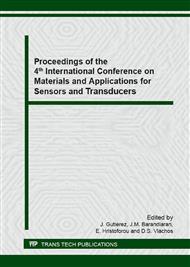p.101
p.106
p.110
p.115
p.120
p.125
p.129
p.133
p.137
Printable, Transparent Force Sensing Resistive Materials for Touchscreen Applications
Abstract:
A transparent, force sensing resistive ink suitable for touchscreen technology is presented, which is capable of detecting both touch location and the applied force. The force sensing behavior is realized by a screen-printed ink layer which consists of pre-formed semi-conductive granules dispersed in an insulating polymer. The granule size is of a comparable dimension to the thickness of the printed layer. Conduction is via the creation of pressure-induced conductive pathways through the layer at the contact point. With increasing force the number of pathways increases and the resistance of the pathways decreases, reducing the resistance through the layer. The electrical behavior was tested with finger-press forces up to 5 N using a load cell and stylus attachment. Optical properties of the touchscreen were assessed using a spectrophotometer to measure the transmitted light over the range of visible wavelengths. Both the force-resistance profiles and the optical properties of the layer are dependent on the granule loading and composition. The structural, optical and force-resistance performance of test devices are discussed.
Info:
Periodical:
Pages:
120-124
Citation:
Online since:
May 2015
Authors:
Price:
Сopyright:
© 2015 Trans Tech Publications Ltd. All Rights Reserved
Share:
Citation:


